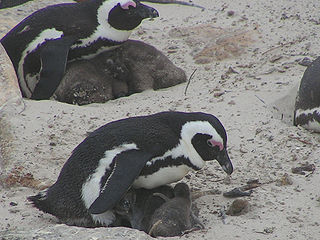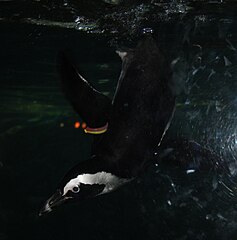Penguins are beloved by bird enthusiasts and “regular” people alike. While they are not typically thought of as “pets”, in the course of my zoo career I have run into several people who have managed to keep penguins in their personal collections. One such instance involved a well-known entertainer who donated his flock of flamingoes – which he housed in a climate-controlled building in the desert just outside Las Vegas – to the Bronx Zoo in order to make room for penguins! I’ve had the good fortune to work with several species in zoos and today would like to cover the care and natural history of a great favorite, the African Penguin, aka the Black-Footed or Jackass Penguin, Spheniscus demersus.
Captive Care
Penguins are demanding captives…I found this to be true even though I had the Bronx Zoo’s resources, and the expertise of experienced co-workers, at my disposal. Most species lack defenses to local fungi, bacteria and parasites …in NYC, West Nile proved to be especially dangerous. The range of preventative medications and vitamin supplements they require necessitated that I hand feed each daily – an enjoyable but tedious task. They learn to “line up” for food right away, but squabble continually…and the numerous wing tags attached to each bird complicated individual identification (the opposite of a wing tag’s intended purpose!).
Also, penguin social behavior is quite complex. One hand-raised youngster made a delightful “companion” when following me about on my rounds, but he did not behave normally around other penguins and was attacked each time I tried to integrate him into the group.
Range
The Black-footed or African Penguin’s loud, braying call has earned it the alternative name of Jackass Penguin (2 other species also have this dubious honor). Standing 2 feet tall and weighing in at 4-12 pounds, it is the only one of the world’s 18 penguin species to nest in Africa. The Black-foot’s breeding range stretches from the South Africa-Namibia border 500 miles south, and around the bottom of the continent to Port Elizabeth, South Africa.
Outside of the breeding season, African Penguins disperse north to southern Angola and northern South Africa. Strays appear as far north as Gabon and central Mozambique. Gabon (and, in the Western Hemisphere, the Galapagos Islands) represents the northernmost limits of penguin distribution (except for 2 individuals that somehow wound up off Newfoundland!).
Adaptations to High and Low Temperatures
The African Penguin must deal with hot weather and cold water simultaneously. To cool off, African Penguins shunt blood to a featherless patch of skin located in front of each eye, whereupon heat is dissipated into the air. The relatively large flippers assist in the same manner, and, like most birds, they engage in gular flapping (“panting”) as well.
The cold Benguela and Angulas Currents, which run through the African Penguin’s range, necessitate adaptations to low temperatures. In common with its relatives, it is protected by 3 layers of feathers and has evolved a unique heat-exchange system. This system allows venous blood that has been chilled by circulation to the flippers and legs to be warmed by outgoing arterial blood.
Diving and Swimming
Dense bones (those of most birds are hollow) assist all penguins in submerging quickly, so that foraging time can be maximized. Field studies suggest that the average African Penguin dive lasts 2.5 minutes and reaches depths of 90-400 feet. The much larger Emperor Penguin can remain submerged 22 minutes, while hunting at depths of nearly 2,000 feet below the surface! In order to sustain such protracted dives, the heart rate slows from approximately 100 to 20 beats per minute; penguin muscles have evolved the ability to function on a greatly reduced supply of blood and oxygen.
There are anecdotal reports of African Penguins attaining swimming speeds of 12 miles per hour, but in controlled tests they typically top out at half that.
Reproduction
Unlike many birds, African Penguins breed year-round, but there are noticeable peaks and lulls in reproductive activity. They form long term pair bonds, with 80-90% of the pairs remaining stable, in some cases for at least 10 years. The 2 eggs are deposited in self-dug burrows or natural depressions beneath rocks and bushes. Both parents incubate, with each staying on the nest for 1-2 days at a time.
The young fledge at age 60-130 days, after which they disperse for 1-2 years. Sexual maturity is usually reached at age 4, and the typical lifespan is 8-10 years; captives have survived into their mid-20’s.
Status and Conservation
African Penguins breed in one of the world’s most productive fishing areas, and the species they favor – pilchards, anchovies, mackerel and squid – are heavily utilized by people. A developing fishery for krill will further impact food availability. Oil tanker routes around the Cape of Good Hope also threaten this species’ future.
Ten of the 37 known African Penguin breeding colonies are no longer active, and the overall population is believed to have declined by 90% since 1900. African Penguins are designated as “Vulnerable” by the IUCN and listed on Appendix II of CITES.
 That Bird Blog – Bird Care and History for Pet Birds
That Bird Blog – Bird Care and History for Pet Birds






